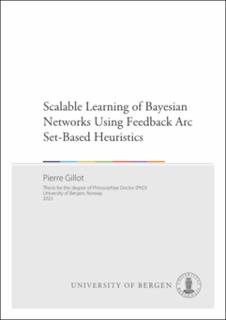| dc.contributor.author | Gillot, Pierre | |
| dc.date.accessioned | 2023-10-27T11:15:55Z | |
| dc.date.available | 2023-10-27T11:15:55Z | |
| dc.date.issued | 2023-11-10 | |
| dc.date.submitted | 2023-10-10T08:52:20.120Z | |
| dc.identifier | container/bd/01/7b/23/bd017b23-59bb-4ced-9b99-d975655047a4 | |
| dc.identifier.isbn | 9788230857007 | |
| dc.identifier.isbn | 9788230869017 | |
| dc.identifier.uri | https://hdl.handle.net/11250/3099149 | |
| dc.description.abstract | Bayesianske nettverk er en viktig klasse av probabilistiske grafiske modeller. De består av en struktur (en rettet asyklisk graf) som beskriver betingede uavhengighet mellom stokastiske variabler og deres parametere (lokale sannsynlighetsfordelinger). Med andre ord er Bayesianske nettverk generative modeller som beskriver simultanfordelingene på en kompakt form.
Den største utfordringen med å lære et Bayesiansk nettverk skyldes selve strukturen, og på grunn av den kombinatoriske karakteren til asyklisitetsegenskapen er det ingen overraskelse at strukturlæringsproblemet generelt er NP-hardt. Det eksisterer algoritmer som løser dette problemet eksakt: dynamisk programmering og heltalls lineær programmering er de viktigste kandidatene når man ønsker å finne strukturen til små til mellomstore Bayesianske nettverk fra data. På den annen side er heuristikk som bakkeklatringsvarianter ofte brukt når man forsøker å lære strukturen til større nettverk med tusenvis av variabler, selv om disse heuristikkene vanligvis ikke har teoretiske garantier og ytelsen i praksis kan bli uforutsigbar når man arbeider med storskala læring.
Denne oppgaven tar for seg utvikling av skalerbare metoder som takler det strukturlæringsproblemet av Bayesianske nettverk, samtidig som det forsøkes å opprettholde et nivå av teoretisk kontroll. Dette ble oppnådd ved bruk av relaterte kombinatoriske problemer, nemlig det maksimale asykliske subgrafproblemet (maximum acyclic subgraph) og det duale problemet (feedback arc set). Selv om disse problemene er NP-harde i seg selv, er de betydelig mer håndterbare i praksis. Denne oppgaven utforsker måter å kartlegge Bayesiansk nettverksstrukturlæring til maksimale asykliske subgrafforekomster og trekke ut omtrentlige løsninger for det første problemet, basert på løsninger oppnådd for det andre.
Vår forskning tyder på at selv om økt skalerbarhet kan oppnås på denne måten, er det adskillig mer utfordrende å opprettholde den teoretisk forståelsen med denne tilnærmingen. Videre fant vi ut at å lære strukturen til Bayesianske nettverk basert på maksimal asyklisk subgraf kanskje ikke er den beste metoden generelt, men vi identifiserte en kontekst - lineære strukturelle ligningsmodeller - der vi eksperimentelt kunne validere fordelene med denne tilnærmingen, som fører til rask og skalerbar identifisering av strukturen og med mulighet til å lære komplekse strukturer på en måte som er konkurransedyktig med moderne metoder. | en_US |
| dc.description.abstract | Bayesian networks form an important class of probabilistic graphical models. They consist of a structure (a directed acyclic graph) expressing conditional independencies among random variables, as well as parameters (local probability distributions). As such, Bayesian networks are generative models encoding joint probability distributions in a compact form.
The main difficulty in learning a Bayesian network comes from the structure itself, owing to the combinatorial nature of the acyclicity property; it is well known and does not come as a surprise that the structure learning problem is NP-hard in general. Exact algorithms solving this problem exist: dynamic programming and integer linear programming are prime contenders when one seeks to recover the structure of small-to-medium sized Bayesian networks from data. On the other hand, heuristics such as hill climbing variants are commonly used when attempting to approximately learn the structure of larger networks with thousands of variables, although these heuristics typically lack theoretical guarantees and their performance in practice may become unreliable when dealing with large scale learning.
This thesis is concerned with the development of scalable methods tackling the Bayesian network structure learning problem, while attempting to maintain a level of theoretical control. This was achieved via the use of related combinatorial problems, namely the maximum acyclic subgraph problem and its dual problem the minimum feedback arc set problem. Although these problems are NP-hard themselves, they exhibit significantly better tractability in practice. This thesis explores ways to map Bayesian network structure learning into maximum acyclic subgraph instances and extract approximate solutions for the first problem, based on the solutions obtained for the second.
Our research suggests that although increased scalability can be achieved this way, maintaining theoretical understanding based on this approach is much more challenging. Furthermore, we found that learning the structure of Bayesian networks based on maximum acyclic subgraph/minimum feedback arc set may not be the go-to method in general, but we identified a setting - linear structural equation models - in which we could experimentally validate the benefits of this approach, leading to fast and scalable structure recovery with the ability to learn complex structures in a competitive way compared to state-of-the-art baselines. | en_US |
| dc.language.iso | eng | en_US |
| dc.publisher | The University of Bergen | en_US |
| dc.relation.haspart | Paper I: Pierre Gillot & Pekka Parviainen, Scalable Bayesian Network Structure Learning via Maximum Acyclic Subgraph, Proceedings of the 10th International Conference on Probabilistic Graphical Models, PMLR 138:209-220, 2020. The article is available in the thesis file. | en_US |
| dc.relation.haspart | Paper II: Pierre Gillot & Pekka Parviainen, Learning Large DAGs by Combining Continuous Optimization and Feedback Arc Set Heuristics, Proceedings of the AAAI Conference on Artificial Intelligence, 36(6):6713-6720, 2022. The article is not available in BORA due to publisher restrictions. The published version is available at: <a href="https://doi.org/10.1609/aaai.v36i6.20626" target="blank">https://doi.org/10.1609/aaai.v36i6.20626</a> | en_US |
| dc.relation.haspart | Paper III: Pierre Gillot & Pekka Parviainen, Convergence of Feedback Arc Set-Based Heuristics for Linear Structural Equation Models, Proceedings of the 11th International Conference on Probabilistic Graphical Models, PMLR 186:157-168, 2022. The article is available in the thesis file. | en_US |
| dc.rights | In copyright | |
| dc.rights.uri | http://rightsstatements.org/page/InC/1.0/ | |
| dc.title | Scalable Learning of Bayesian Networks Using Feedback Arc Set-Based Heuristics | en_US |
| dc.type | Doctoral thesis | en_US |
| dc.date.updated | 2023-10-10T08:52:20.120Z | |
| dc.rights.holder | Copyright the Author. All rights reserved | en_US |
| dc.description.degree | Doktorgradsavhandling | |
| fs.unitcode | 12-12-0 | |
